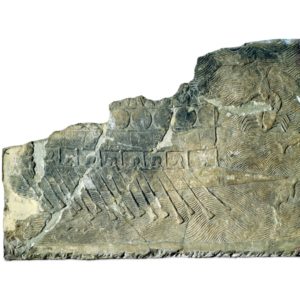Jesus’ Fish
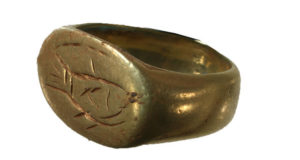
In 2010, we identified the earliest Christian symbol – contemporary with the first followers of Jesus. It’s a fish carved on the side of a bone box (or “ossuary”), discovered in Jerusalem. The controversial fish has been largely ignored because – to mix metaphors – he upsets too many theological apple carts. A new discovery, however, should propel the fish back to the forefront of Jesus-related archaeology.
But let’s flash back.
In the Gospels, Jesus’ followers ask him for a “sign” that he is the long-awaited Messiah, God’s anointed one. Jesus is upset with this question, believing that the answer should be obvious to one and all. Irritated, he calls the people asking him for a sign part of a “wicked generation”. But he finally relents and gives them a “sign” – one sign and no other.
This is what Jesus says: “A wicked and adulterous generation looks for a sign, but none will be given it except the sign of Jonah” (Matthew 16:4 – also in Luke 11:29). This answer left people mystified – what did Jesus mean by the “Sign of Jonah”? After the crucifixion, his followers understood this “Sign” as a hint. What Jesus meant, they reasoned, was: just as Jonah was three days in the belly of the big fish and lived, so, too, the “Son of Man” would be three days in the belly of the tomb, and then be raised (see John 2:20-22).
As a result of all this, the “Sign of Jonah” became the earliest symbol of the followers of Jesus, i.e. the earliest symbol of Christianity. We find it, for example, in the catacombs (subterranean Christian graveyard) of Rome, where Jonah is depicted being spit out of a great sea monster.
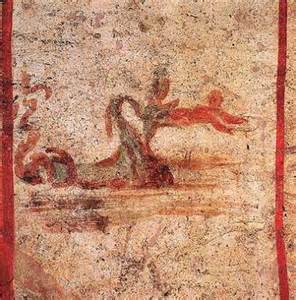
Cut to:
In 2007, we identified the tomb of Jesus in Talpiot, Jerusalem.
The above fact upset a lot of people because they would like the tomb to be under the Church of the Holy Sepulchre in Jerusalem. Their “logic” goes this way: the tomb of the Holy Sepulchre is Jesus’ tomb because there’s nothing there. Since Jesus left the tomb three days after his death, and physically rose to heaven thirty days after his resurrection, the “proof” that the Church of the Holy Sepulchre is Jesus’ tomb is that it’s totally empty. It’s called the “Empty Tomb”. According to this logic, the lack of evidence is the proof of authenticity. For his part, Jesus is in heaven, body and all.
It seems this form of argumentation convinces many Christian believers, and even some Israeli archaeologists such as Amos Kloner, Shimon Gibson and my friend Danny Bahat. They argue that the Church of the Holy Sepulchre fits nicely with the tradition of Jesus’ burial, despite the fact that there is zero evidence to that effect.
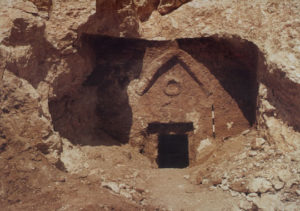
For my part, I like the tomb in Talpiot. For starters, there’s an actual tomb there. Not only that, it has a unique symbol on its façade. Furthermore, it wasn’t found empty. When it was discovered in 1980, it had ten ossuaries in it. Six were inscribed with names. Unlike the Church of the Holy Sepulchre, where there are no ossuaries and no inscriptions, this tomb had a certain “Jesus, son of Joseph” buried there. Next to him there was a “Maria”. Next to her, there was a “Yose”, a name specifically linked to one of Jesus’ brothers (Mark 6:3, Matthew 13:55). Next to them, there was a “Mariamene”, a Greek version of “Mary” that in all of Greek literature is associated with Mary Magdalene and no one else. You’d think that someone would find all this compelling. It’s certainly better than zero evidence under the Church of the Holy Sepulchre, isn’t it? But, no. The naysayers accuse me of sensationalism. Jesus was a common name, they say. This tomb belonged to some other Jesus, two other Marys and another Joseph.
To get back to the troublesome fish:
With the naysayers booing and blogging from the stands, we proceeded to investigate the tomb next to the Talpiot Jesus tomb. This so-called “Patio Tomb”, which remains sealed under a patio, could not be excavated because of Haredi (Jewish ultra Orthodox) opposition. From their perspective, excavation disturbs the dead. So we built a robotic arm that allowed us to photograph without excavating. The HiDef GE camera at the end of a specially designed robotic arm gave us a unique look at the ossuaries still inside the Patio Tomb. One ossuary has inscribed on it the only 1st-century statement of resurrection faith ever found on any bone box excavated in the land of Israel. You’d think someone would get excited, but this discovery was met with a deafening silence.
Another ossuary has a cross on it, but the naysayers said that the cross was not a Christian symbol prior to the 4th century. Nevermind that Christian crosses were found in a 1st century bakery in Pompeii and in a chapel in Herculaneum… It was decided that the cross in the Patio Tomb is not a cross – it’s a door.
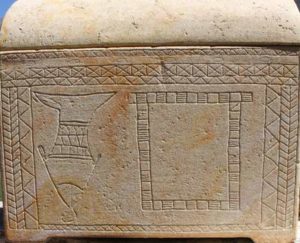
We then discovered the image of a fish spitting out a stick figure on the side of one ossuary. As stated above, this is the “Sign of Jonah”, the most prevalent Biblical image used by Christians in Rome’s catacombs… only our image is 200 years earlier than the catacombs. Applause? None. Only more derision. Why? Simple: if the Patio Tomb has the earliest Christian symbols found anywhere on the planet, then the tomb next door must be Jesus’ tomb. Put differently, if the ossuary with the Jonah symbol is really an ossuary with a Jonah symbol, then the Jesus buried next door is not any old Jesus – it’s Jesus of Nazareth. So the naysayers have to negate the findings in the Patio Tomb.
Here’s their argument: the Jonah image is not a Jonah image (never mind that it actually says “Yonah” on the fish, in clear Hebrew letters read this way by professors Tabor, Charlesworth, Puech and Hachlili). In fact, it’s not even a depiction of a fish (after all, fish are the earliest symbols of Christianity, and the naysayers don’t want it to be a Christian symbol). First of all, the fish is drawn vertically on the ossuary. There’s no such thing as a vertical fish, they say – obviously, they haven’t been fishing. But, more importantly, their second objection to the fish is that it’s “sexy”. Let me explain. The Talpiot fish has a “waist line”, i.e., it curves in and out, and according to the naysayers it should be elliptical.
But now, in Tel Megiddo in the Jezreel Valley, the legendary “Armageddon” in Northern Israel, they have found a treasure trove of 3,000-year-old Canaanite gold jewelery. One of them is a ring, and on the ring there’s – what do you know – a fish. And it’s a very fit fish, because it’s not elliptical but has a waist line (see top of post). It seems that that’s how they drew fishes in Israel for a thousand years before Jesus. In fact, it seems that this is the eastern fish tradition, as opposed to western tradition. For example, on a sculpture from the palace of King Sennacherib (705-681 BC) at Ninveh, modern Iraq, there is a carving of Assyrian oarsmen negotiating the fast river in a coracle (a round boat). All around there are fish in various positions, i.e. vertical and horizontal, right side up and upside down. There’s also a carving of Phoenecian oarsmen and next to them in the water there’s at least one upside-down fish that is not elliptical, but with a “waist line”. Put simply, all these Assyrian fish look exactly like the Jonah fish in Talpiot.
So the evidence is mounting. The fish is a fish and it’s next to a cross that’s a cross, and it’s next to a resurrection statement that’s really a resurrection statement, and all that is next to a tomb that, for two thousand years, housed the mortal remains of a man by the name of “Jesus son of Joseph”.

